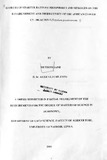| dc.description.abstract | A study was conducted at Kabete between October 1999 and July 2000 to determine the
effects of starter rates of phosphorus, nitrogen and stubble height on establishment and
productivity of African clover (Tquartinianum cv. Mealton 5). Soil was analyzed for
available phosphorus and total nitrogen before planting and after harvesting. To
determine establishment, field plant counts were taken biweekly. Dry matter (taken at
120 and 180 days after planting), nodules per plant, plant cover and plant height (taken
biweekly) were used to determine Mealton 5 productivity. Percent leaf crude protein
(taken after the final harvests) was used to determine nutritive quality of the clover.
Weather elements for the entire study period were recorded. The experiment was laid
out in Randomized Complete Block Design (RCBD) in three blocks with four
treatments. These were:-control (PoNo), nitrogen alone at 27 kg N!ha as urea (46 % N)
(PoNd, phosphorus alone at 30 kg P!ha as Triple super phosphates (TSP) (20 % P)
(PINo) and a combination of phosphorus and nitrogen at 30 kg P/27 kg N per hectare
(P IN I). First experiment was carried out from October 1999 to April 2000, while the
second one was from January 2000 to July 2000. Four growth stages were observed in
the growth life of this clover. Weather conditions affected the performance ofthis
clover. Seed germination was 90-95% 11 days after the experiment was initiated. Plant
field establishment was enhanced more by application of both nitrogen and phosphorus
than application of each fertilizer alone. Seedling counts declined with time due to
mortality. Plant cover was highest in TSP alone and TSP plus urea treatments from midsecond quarter of growth until final harvest. The control treatment had the poorest cover throughout. The same trend was observed in plant height. Decline in cover in the fourth quarter was possibly due to leaf fall.
Nodules per plant were significantly (P=0.05) increased by phosphorus application.
They were highest in TSP alone followed by TSP plus urea. Control and urea alone,
respectively had fewer nodules. Dry matter yields were significantly (P=0.05) increased
by phosphorus application while urea alone had lesser effect. Cutting height had no
significant effects. Percent leaf crude protein was significantly (P=0.05) higher in
fertilized plots than in the control. There was an increase in soil nitrogen with fertilizer
application after harvesting clover than before planting. This was enhanced by
phosphorus application. An increase in soil available phosphorus was observed after
harvesting plants under TSP alone and TSP plus urea treatments. Correlation among
variables was generally positive. Several of the variables are mostly definitely
associated with dry matter yields in Mealton 5.
Application of phosphorus at 30 kg Plha as Triple super phosphates (TSP) or phosphorus plus nitrogen at 30 kg P plus 27 kg N (as urea) per hectare gave the highest dry matter yields and percent leaf crude proteins as well as soil nitrogen and phosphorus content under conditions of this study. | en |

